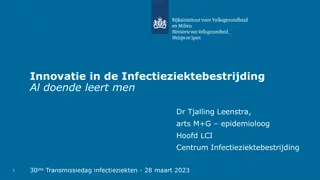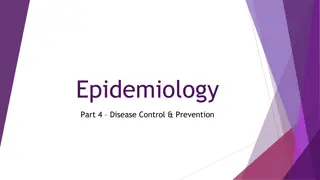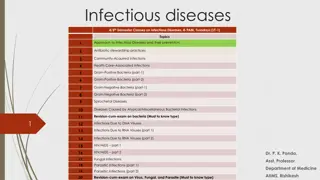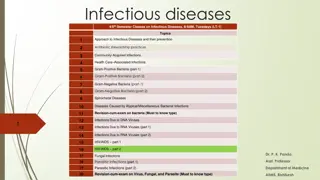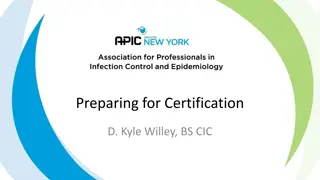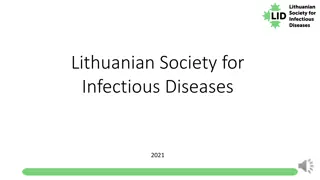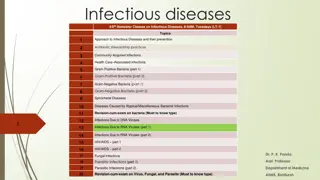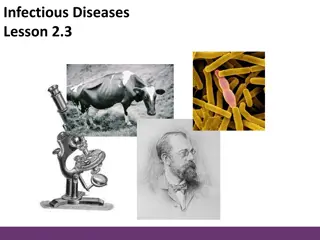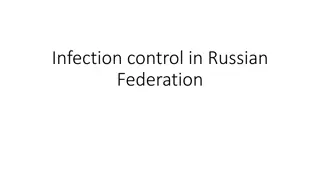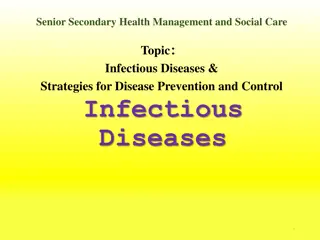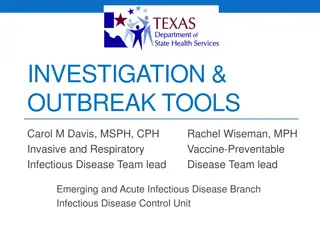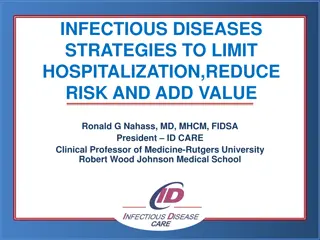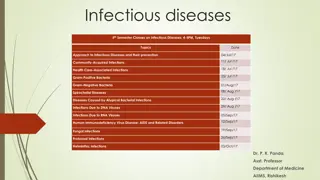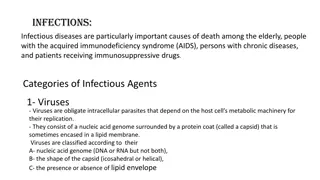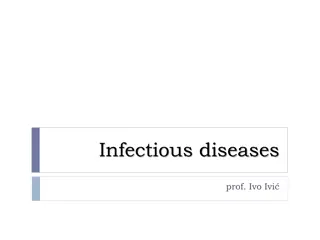
Harnessing the Power of Infectious Disease Information
Infectious diseases play a significant role in global public health, with about one half of all deaths in developing countries attributed to them. This presentation focuses on utilizing a relational database to manage and analyze infectious disease information effectively. It emphasizes the importance of medical surveillance, prevention, and information dissemination in overcoming the challenges posed by infectious diseases. The speaker, Jay A. Brown, MD, MPH, highlights the evolution of infectious disease knowledge and the need for continuous efforts to control and prevent these diseases on a global scale.
Download Presentation

Please find below an Image/Link to download the presentation.
The content on the website is provided AS IS for your information and personal use only. It may not be sold, licensed, or shared on other websites without obtaining consent from the author. If you encounter any issues during the download, it is possible that the publisher has removed the file from their server.
You are allowed to download the files provided on this website for personal or commercial use, subject to the condition that they are used lawfully. All files are the property of their respective owners.
The content on the website is provided AS IS for your information and personal use only. It may not be sold, licensed, or shared on other websites without obtaining consent from the author.
E N D
Presentation Transcript
1 3/13/2025 HARNESSING THE POWER OF INFECTIOUS DISEASE INFORMATION WITH A RELATIONAL DATABASE
2 3/13/2025 Presenter Disclosures I developed IDdx: Infectious Disease Queries which is currently a free download from Apple Store (iPhone or iPad) and Google Play (Android phone).
3 3/13/2025 Presented by Jay A. Brown, MD, MPH Consultant for the U.S. National Library of Medicine
4 3/13/2025 Using infectious disease information is an important priority in global public health.
Medical Surveillance and Prevention Index & Map Disseminate On the Internet Analyze & Interpret Control & Prevent Collect Data
About one half of all deaths in developing countries are caused by infectious diseases.
Infectious diseases are no longer confined by geographical boundaries.
An outbreak of SARS in China can become an outbreak in Toronto a few days later.
A vast treasury of infectious disease knowledge has been discovered in the last 150 years
This knowledge, summarized in Control of Communicable Diseases Manual, includes signs & symptoms, diagnostic tests, geographical occurrence, mode of transmission, incubation period, and risk factors.
With the current availability of fast hand- held computers, the Internet, and easy-to- use relational database software, the stage is set for the eradication or control of many infectious diseases that have ravaged mankind for thousands of years.
. . . some diseases are close to being eliminated or eradicated completely, among them poliomyelitis, leprosy, neonatal tetanus, guinea-worm infection and Chagas disease." [WHO]
A properly designed and updated relational database of infectious diseases can serve as a decision-support tool for physicians and other healthcare professionals.
Information can be instantaneously updated for frontline doctors, who can query the database for all diseases that match specific symptoms, an occupation, a region of the world, or an insect vector.
The results of a query become a differential diagnosis list based on the criteria of the query.
23 3/13/2025 How AND Queries Work
For example, the user can find that 7 of 249 diseases match the criteria of "jaundice" and "ticks."
In summary, all useful infectious disease information can be collected and indexed into a relational database to help practitioners quickly build differential diagnoses and find details about specific diseases.
27 3/13/2025 Some Examples of Search Criteria for Zoom-Intersection FINDINGS ENTRY VECTOR RESERVOIR Abdominal pain Inhale Biting flies Birds Encephalitis Ingest Fleas Cats Pneumonia Animal bite Lice Cattle Jaundice Needle Mosquitoes Dogs Stiff Neck Sexual Ticks Fish
29 3/13/2025 Medical Informatics Problem 1. There is an explosion of information about infectious diseases. 2. How can we find the specific information we need when we need it?
30 3/13/2025 Public Health Informatics Solution 1. Use available technology. 2. Index and map the wealth of information. 3. Create an intelligent database to store the information in such a way that specific information can be easily retrieved. 4. Use the Internet and mobile Apps to disseminate the information for improvement of medical practice and prevention.
31 3/13/2025 Relational Database: A New Tool for Indexing and Mapping Information Like a company database of employees, customers, products, and invoices, information is stored in tables that are linked together. Indexing is done first by developing a controlled vocabulary specific for the knowledge domain. Queries allow finding information by search criteria (the indexes) including OR and AND searches. Categories are used to drill down to find information.
32 3/13/2025 Indexing: At the Heart of Intelligence Indexing is a major problem at the heart of intelligence. [Roger Schank. Tell Me a Story, p. 11] No intelligent system is likely to function effectively if it cannot find what it knows when it needs to know it. [Schank, p. 112] Show all diseases that match one or more criteria: Central Africa AND petechial rash; Cat contact AND diarrhea; Tick exposure AND anemia;
33 3/13/2025 Indexes Used in IDdx Signs and Symptoms Endemic Regions of the World Epidemiological Factors Entry Source Vector Reservoir Occupations Incubation Periods
34 3/13/2025 Sources of Information Best and most recent; Starting point is latest edition of Control of Communicable Diseases Manual (CCDM); Now available for full-text online access are CCDM, Principles and Practice of Infectious Diseases (PPID), Infectious Diseases (Cohen), and Tropical Infectious Diseases (Guerrant); Disease findings in IDdx were checked by doing text searches for each finding in each of the online books.
35 3/13/2025 References in IDdx For a full list of all references used in IDdx, see the bibliography page at http://www.iddx.com/bibliography.html
36 3/13/2025 Knowledge Mapping Decision support systems can provide preliminary analysis that allows scarce human resources to focus on the key problems while ignoring a vast sea of irrelevancy. [O Carroll et al. 2003] Knowledge is information in context. Mapping means pulling together and sifting information from a lot of different sources. Knowledge mapping is comprehensively collecting and systematically indexing a knowledge domain.
37 3/13/2025 Knowledge Mapping Begins with the big picture; Helps one not to get lost in the details; Keeps all information in context of the whole; Distills the facts from the vast sea of data; Most useful in information-intensive specialties;
38 3/13/2025 Categories of Findings Prefix Finding Category Prefix Finding Category > General O Ophthalmologic C Cardiovascular R Respiratory E Ears, Nose & Throat Gastrointestinal S Skin G U Genitourinary H Hematologic X Chest X-ray M Musculoskeletal * Complication
39 3/13/2025 Four Major Tables in the Database Findings Diseases Job Tasks Jobs
40 3/13/2025 Each Table Contains Records 249 Diseases 99 Findings 63 Job Tasks 94 Jobs
41 3/13/2025 Which Diseases Are Covered? The 249 diseases are very similar to those covered in the latest edition of Control of Communicable Diseases Manual (CCDM). Each disease is linked to high-risk job tasks (63), signs & symptoms (99), epidemiological factors (39), endemic regions of the world (16), and incubation periods (7). The main categories of diseases are arthropod-borne, childhood, person-to-person, foodborne, gastroenteritis, localized infections, sapronoses, sexually-transmitted, and zoonoses.
42 3/13/2025 High-Risk Job Tasks and Prevention Identify high risk groups. What are the specific job tasks that put workers at risk for the disease? Each hazardous job task links to one or more disease and one or more jobs.
Examples of Hazardous Job Tasks Handle infected rodents (bite); Handle infected rodents (not bite); Handle dog or cat (bite or scratch); Have dog or cat contact (fecal-oral); Handle needles or surgical instruments; Care for patients (fecal-oral pathogens); Work in a medical or research lab; Live together in close quarters; 43 3/13/2025
Examples of Hazardous Job Tasks Plow or excavate soil in endemic area; Raise dust of excreta from rodents; Travel to endemic area; Work in building infested with fleas; Work or play in tick-infested area; For a summary of how jobs relate to infectious diseases through job tasks, see these two pages on the Haz-Map website: Occupational Infections and Skin Infections. 44 3/13/2025
45 3/13/2025 For More Information See "Using a Relational Database to Index Infectious Disease Information" published in 2010 in the Int. J. Environ. Res. Public Health. The full-text article is available at: www.mdpi.com/1660-4601/7/5/2177/. See the IDdx website at www.iddx.com.

